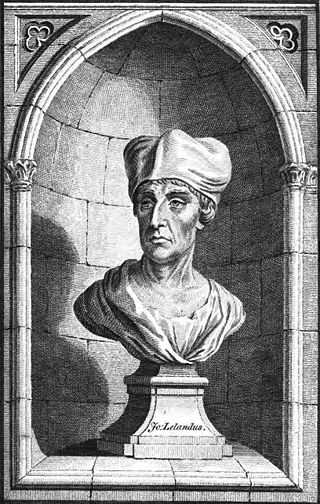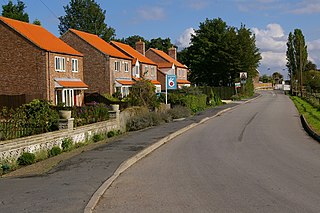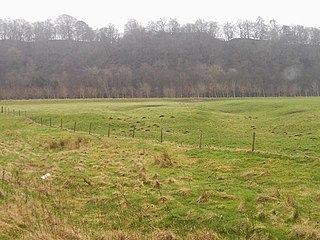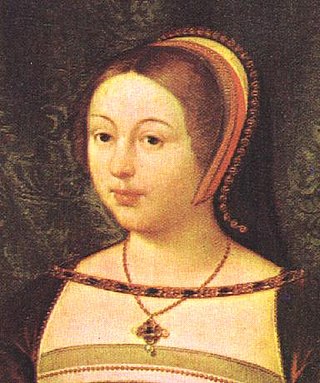
Margaret Tudor was Queen of Scotland from 1503 until 1513 by marriage to King James IV. She then served as regent of Scotland during her son's minority, and successfully fought to extend her regency. Margaret was the eldest daughter and second child of King Henry VII of England and Elizabeth of York, and the elder sister of King Henry VIII of England.

Pershore Abbey, at Pershore in Worcestershire, was an Anglo-Saxon abbey and is now an Anglican parish church, the Church of the Holy Cross.

John Leland or Leyland was an English poet and antiquary.

Cottingham is a large village and civil parish in the East Riding of Yorkshire, England with average affluence. It lies 4 miles (6.4 km) north-west of the centre of Kingston upon Hull, and 6 miles (9.7 km) south-east of Beverley on the eastern edge of the Yorkshire Wolds. It has two main shopping streets, Hallgate and King Street, which cross each other near the Church of Saint Mary the Virgin, and a market square called Market Green. Cottingham had a population of 17,164 residents in 2011, making it larger by area and population than many towns. As a result, it is one of the villages claiming to be the largest village in England.

Wressle is a village and civil parish in the East Riding of Yorkshire, England, lying on the eastern bank of the River Derwent approximately 3 miles (5 km) north-west of Howden.

Fulk FitzWarin, variant spellings, the third, was a prominent representative of a marcher family associated especially with estates in Shropshire and at Alveston in Gloucestershire. In young life, early in the reign of King John (1199–1216), he won notoriety as the outlawed leader of a roving force striving to recover his familial right to Whittington Castle in Shropshire, which John had granted away to a Welsh claimant. Progressively rehabilitated, and enjoying his lordship, he endured further setbacks in 1215–1217.

Elmley Castle is a village and civil parish in Worcestershire, in England, United Kingdom. It is located on the north side of Bredon Hill 3 miles south-east of Pershore in the local government district of Wychavon.
Haltemprice Priory was an Augustinian monastery approximately two miles south of the village of Cottingham in the East Riding of Yorkshire, England. The original monastic buildings have long since gone, although ruins of a farmhouse, built in 1584, remain on site and incorporate some of the Priory stonework.

Newland is a suburb of Kingston upon Hull, East Riding of Yorkshire, England, in the north-west of the city, a former village on the Hull to Beverley turnpike.
Dr Richard Gwent was a senior ecclesiastical jurist, pluralist cleric and administrator through the period of the Dissolution of the Monasteries under Henry VIII. Of south Welsh origins, as a Doctor of both laws in the University of Oxford he rose swiftly to become Dean of the Arches and Archdeacon of London and of Brecon, and later of Huntingdon. He became an important figure in the operations of Thomas Cromwell, was a witness to Thomas Cranmer's private protestation on becoming Archbishop of Canterbury, and was Cranmer's Commissary and legal draftsman. He was an advocate on behalf of Katherine of Aragon in the proceedings against her, and helped to deliver the decree of annulment against Anne of Cleves.
Robert de Graystanes, also known as Robert Greystones or Robert Graystanes, was a 14th-century English Benedictine monk, an unsuccessful candidate to become bishop of Durham around 1333, and supposed chronicler of the church of Durham.

Beverley's town walls are a sequence of defensive structures built around the town of Beverley in the East Riding of Yorkshire, England.
Sir William Whorne was Lord Mayor of London in 1487. He is sometimes also reported as William Horne or William Littlebury.

Liddel Strength is an ancient monument near Carwinley, Cumbria, in northwest England. It consists of the earthwork remains of an Anglo-Norman border fortification destroyed by the Scots in 1346 and fragmentary remains of a pele tower subsequently built upon the site. It lies on a cliff on the south bank of the Liddel Water, overlooking the Liddel Water's confluence with the River Esk; the last high ground before the Esk reaches the Solway Plain. The Liddel Water and the Esk (downstream) form the modern Anglo-Scottish border; formerly they were the southern boundary of the Debatable Lands.

The fortifications of Kingston upon Hull consisted of three major constructions: the brick built Hull town walls, first established in the early 14th century, with four main gates, several posterngates, and up to thirty towers at its maximum extent; Hull Castle, on the east bank of the River Hull, protecting Hull's river harbour, constructed in the mid 16th century and consisting of two blockhouses and a castle connected by a curtain wall; and the later 17th century Citadel, an irregular triangular, bastioned, primitive star fort replacing the castle on the east river bank.
On 19 August 1561, the 18-year-old Mary, Queen of Scots returned to Scotland from France. On 2 September the town of Edinburgh organised a celebration of royal entry for her.

Several documents list the jewels of Margaret Tudor, daughter of Henry VII of England and Elizabeth of York. Margaret married James IV of Scotland in 1503.

Thirsk Castle was a defensive Medieval castle in the town of Thirsk, in North Yorkshire, England. The castle was one of three held by the de Mowbray family in Yorkshire.

Snape Castle is a semi-fortified manor house in the village of Snape, North Yorkshire, England. The castle is 3 miles (5 km) south of Bedale and 19 miles (31 km) north of Ripon. At the time of Henry VIII, John Leland described it as "...a goodly castel in a valley [be]longing to the Lorde Latimer.." The castle is now a private residence, and is a grade I listed building.

The More Taubronar was a musician of African origin at the court of James IV of Scotland and his wife Margaret Tudor. His name is unknown. A "taubron" was a kind of drum, the word is related to the modern form "tabor". The word "More" or "Moryen" was used for people of African origin. Archival records credit the More Taubronar as the producer of a costumed dance or masque performed at the Scottish royal court.















